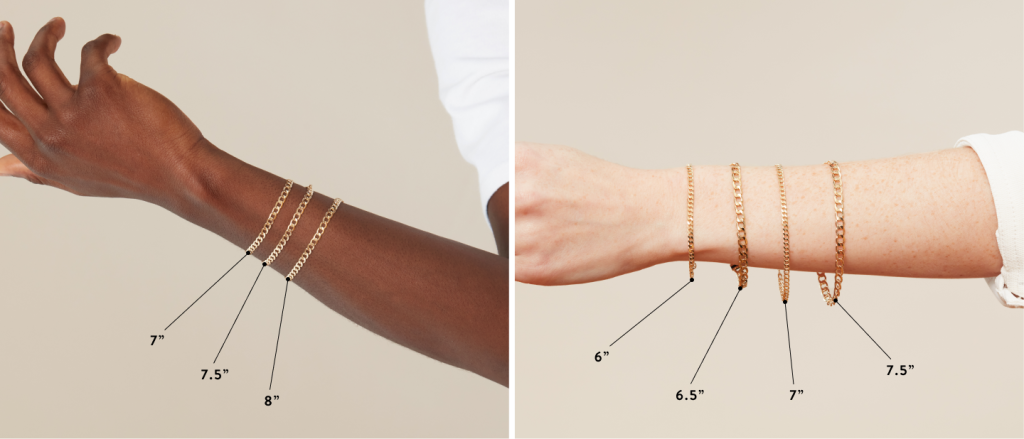Blog
Choosing the Right Bracelet for Your Wrist Size
Choosing the Right Bracelet for Your Wrist Size
Finding the perfect bracelet that fits comfortably and complements your style can make all the difference in your overall look. One of the most important factors to consider when shopping for bracelets is your wrist size. A bracelet that’s too tight can feel uncomfortable and restrict movement, while one that’s too loose might not stay in place or look as polished as you’d like. The right fit ensures that the bracelet stays comfortably in place while enhancing your outfit and adding a touch of sophistication.
In this guide, we will walk you through everything you need to know about choosing the right bracelet for your wrist size, from measuring your wrist correctly to understanding different bracelet types and how to style them for the best fit.
Why Wrist Size Matters When Choosing a Bracelet
Wrist size plays a significant role in determining the fit and overall look of a bracelet. A well-fitted bracelet can sit comfortably on your wrist without feeling too tight or too loose. It also ensures that the bracelet maintains its intended shape and doesn’t shift around too much as you move your arm. Here’s why getting the right size matters:
- Comfort: A bracelet that fits properly will be more comfortable to wear, preventing it from pinching or sliding up and down your arm.
- Aesthetics: The right bracelet size can create a balanced and flattering look. It ensures the bracelet sits in the right spot, whether it’s snug against your wrist or a little looser for a relaxed fit.
- Functionality: Certain bracelet styles, such as cuffs or bangles, may need to be sized correctly to avoid slipping off or getting caught on clothing or other accessories.
Now that you understand the importance of wrist size, let’s dive into how you can measure your wrist and choose the best bracelet for a perfect fit.
How to Measure Your Wrist Size
Before you can choose the right bracelet, you need to know your wrist size. Here’s how to measure it correctly:
What You Need:
- A flexible measuring tape or a piece of string
- A ruler (if you’re using string)
- A pen to mark the measurement
Steps to Measure Your Wrist:
- Wrap the Tape or String Around Your Wrist: Take a flexible measuring tape or a piece of string and wrap it around the widest part of your wrist, typically just above the bone. Make sure it’s snug but not tight, as you want to avoid compressing the skin.
- Mark the Measurement: If using string, mark the point where the ends meet, then measure it with a ruler to find the length. If you’re using a measuring tape, just note the measurement where the tape overlaps.
- Add Extra Room: Add a bit of extra space for comfort. Generally, this is around 0.5-1 inch (1.5 cm) depending on how loose you prefer your bracelet. For bangles or cuffs, this additional room is especially important to ensure they slip on and off without difficulty.
- Double-Check Your Measurement: Make sure to measure your wrist more than once to confirm the size is accurate. Wrist sizes can vary, and a slight mistake in measurement can make a big difference in comfort.
Once you have your wrist size, you can refer to a sizing chart or use it to choose the right bracelet size from a jeweler or retailer.
 Types of Bracelets and Their Fit
Types of Bracelets and Their Fit
Not all bracelets are designed to fit the same way, and each style has its own fit requirements. Here’s a breakdown of the most common bracelet types and how they should fit:
1. Bangles
Bangles are typically circular bracelets that don’t have a clasp or closure. They are meant to be slipped over the hand and worn loosely around the wrist.
- Fit: The key to a perfect bangle fit is to make sure it can slip over your hand without being too tight, but also without sliding too far up your arm. If you’re unsure, try a few different sizes to see which fits most comfortably while still being secure.
- How to Choose: If you have a smaller wrist, choose bangles with a smaller inner diameter (usually around 2.4-2.5 inches), while those with larger wrists may prefer bangles with a diameter of 2.6-2.7 inches.
2. Cuffs
Cuff bracelets are open-ended and are worn by sliding them onto the wrist. They can be worn tight or loose, depending on the style.
- Fit: For a cuff bracelet, it should be snug enough to stay in place without sliding up and down your wrist, but not so tight that it pinches or feels uncomfortable.
- How to Choose: Consider the width of the cuff when choosing the size. Wider cuffs may require a larger size, while narrower cuffs can fit more snugly.
3. Chain Bracelets
Chain bracelets come in various styles, from delicate links to chunkier, more statement-making designs. They usually have a clasp for easy removal and adjustment.
- Fit: Chain bracelets typically have adjustable lengths, so it’s important to choose one with a clasp that fits comfortably. Make sure it isn’t too tight or too loose, as it can shift around your wrist or feel constricting.
- How to Choose: When shopping for a chain bracelet, choose a style that has adjustable links or sizes, so you can easily modify the fit to your liking.
4. Leather Bracelets
Leather bracelets offer a rugged, stylish look and can often be wrapped around the wrist multiple times. Some designs feature clasps, while others are adjustable via knots or loops.
- Fit: Leather bracelets should fit snugly but comfortably around your wrist, allowing enough space for slight movement but not too much.
- How to Choose: When buying a leather bracelet, consider how adjustable the length is. If the bracelet is one-size-fits-all, you may want to check if it’s designed for a specific wrist size range or if it’s adjustable.
5. Stretch Bracelets
Stretch bracelets are made with elastic material, allowing them to stretch over your hand and fit snugly around your wrist.
- Fit: These bracelets should fit comfortably without being too tight or too loose. They should not dig into your wrist, but they should also not slide off easily.
- How to Choose: For stretch bracelets, look for one with an elastic that provides enough stretch to fit over your hand comfortably, but not so much that it slips off or feels insecure.
 Choosing the Right Bracelet for Your Wrist Size
Choosing the Right Bracelet for Your Wrist Size
Once you’ve measured your wrist size, here are some tips for choosing the perfect bracelet:
For Small Wrists
If you have small wrists, it’s important to look for bracelets that won’t overwhelm your arm or slide off easily. Delicate chain bracelets, thin bangles, and adjustable cuffs are great options. Avoid overly wide cuffs or thick, bulky bracelets, as these can make your wrist appear smaller and may be uncomfortable to wear.
For Medium Wrists
Medium-sized wrists offer a lot of versatility when it comes to choosing bracelets. You can comfortably wear most bracelet styles, including wider cuffs, bangles, and chain bracelets. Look for bracelets that are proportional to your wrist size, keeping in mind that balance is key.
For Larger Wrists
Larger wrists may require bracelets with a bit more room to fit comfortably. Look for designs that feature adjustable links, cuffs, or bangles with larger inner diameters. For a stylish look, avoid bracelets that are too tight or that pinch the skin. Choose wider bracelets that will create a balanced, proportional look.
Conclusion
Choosing the right bracelet for your wrist size is crucial for both comfort and style. Whether you prefer delicate chain bracelets, bold cuffs, or versatile bangles, the key is to measure your wrist accurately and choose a bracelet that enhances your look without feeling uncomfortable or too loose. By understanding your wrist size and the fit requirements for different bracelet styles, you can ensure that every piece you wear feels as good as it looks. Happy bracelet shopping!


